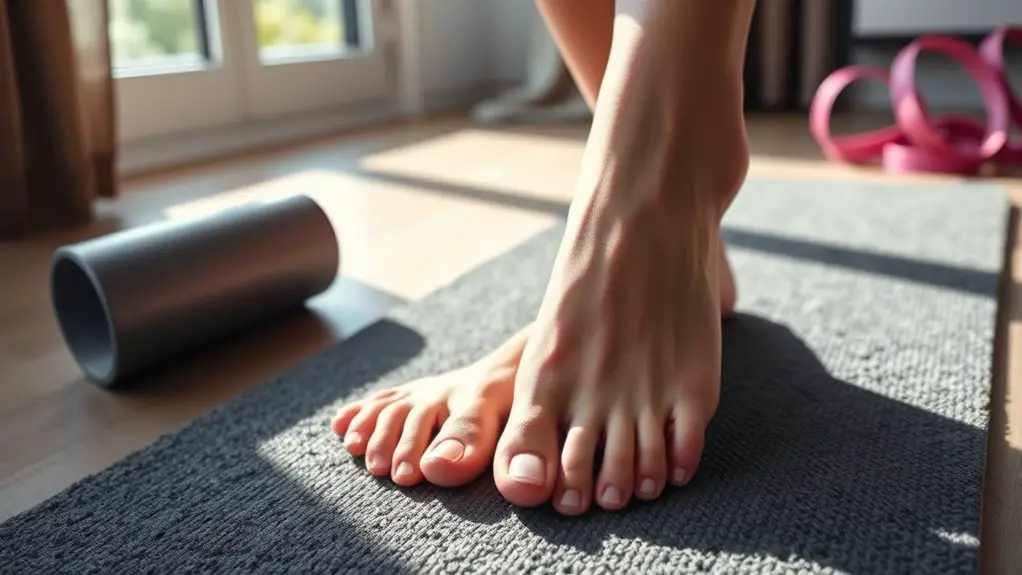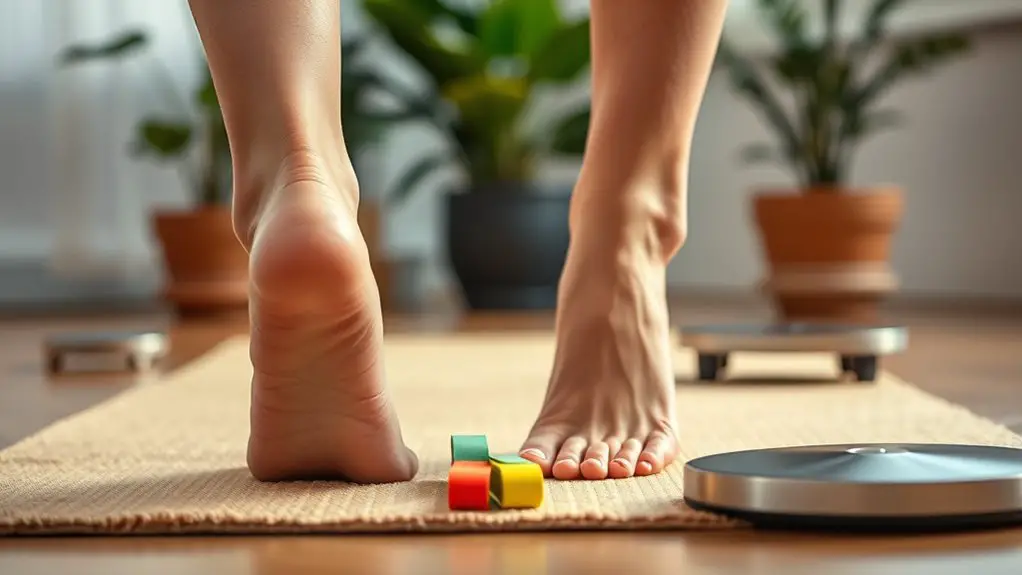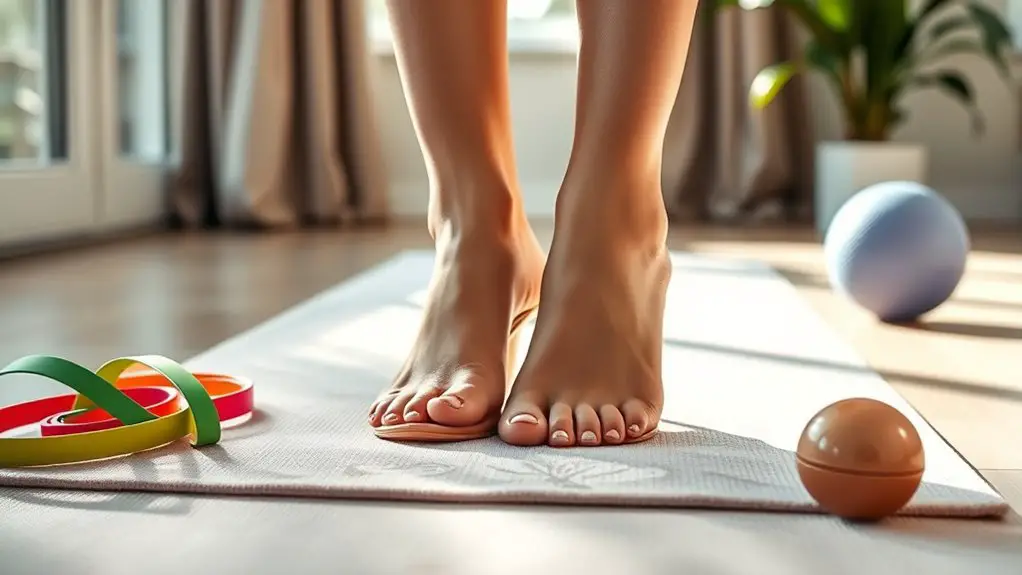To strengthen your feet for high heel wear, focus on exercises like towel scrunches, arch raises, and calf raises. Incorporate toe and ankle exercises, such as marble pickups and single-leg balances, to enhance dexterity and stability. Stretching your calves and performing foot rolls can improve flexibility and reduce tension. Regularly practicing these targeted exercises can lead to stronger, more resilient feet, ultimately improving comfort and mobility. There’s more to discover about creating a thorough routine.
Why Foot Strengthening Is Essential for High Heel Wearers

Wearing high heels can greatly alter foot mechanics, which is why foot strengthening is essential for those who frequently don these stylish yet demanding shoes. High heels shift your body’s center of gravity, placing increased stress on the forefoot and altering the natural alignment of the foot. This change can lead to muscle imbalances and increased risk of injuries, making it vital to focus on strengthening exercises. Additionally, your shoe choice plays a significant role in how your feet adapt. If you regularly choose heels over flats or supportive footwear, your feet may become more susceptible to weakness and pain. Strengthening the intrinsic and extrinsic muscles of the feet can help counteract these effects, improving stability and reducing discomfort. By incorporating targeted exercises into your routine, you can enhance foot mechanics and better prepare your feet for the demands of high heels, ultimately promoting long-term foot health.
The Benefits of Stronger Feet
Stronger feet enhance your balance and stability, which is essential when maneuvering the challenges of high heel wear. Improved strength in your foot muscles also greatly reduces your risk of injuries, such as sprains or strains. By focusing on foot strengthening, you can maintain greater control over your movements and promote overall foot health.
Improved Balance and Stability
As you engage in foot strengthening exercises, you’ll likely notice an improvement in your balance and stability, essential attributes for managing daily activities, especially when wearing high heels. Stronger feet contribute to better foot alignment and enhance core stability, enabling you to navigate your environment with confidence.
Here are some key benefits you’ll experience:
- Improved posture, supporting your overall body alignment.
- Enhanced proprioception, allowing better awareness of your body’s position.
- Increased agility, making quick movements more manageable.
- Greater confidence in walking and standing, reducing the fear of stumbling.
- More efficient energy transfer, reducing fatigue during prolonged high heel wear.
These improvements can lead to a more comfortable and secure experience in your favorite footwear.
Reduced Injury Risk
When your feet are strong, the risk of injury markedly decreases, especially for those who frequently wear high heels. Strengthening exercises enhance your foot muscles, improving their ability to support your weight and absorb shock, reducing strain and potential injuries. Incorporating injury prevention strategies, such as targeted foot exercises, can help you avoid common ailments like plantar fasciitis and ankle sprains. Additionally, coupling strong feet with proper footwear choices is vital. Wearing heels that provide adequate arch support and cushioning can further mitigate injury risks. By prioritizing foot strength and making informed choices about your footwear, you can enjoy the elegance of high heels while minimizing the likelihood of injury. Strong feet are an essential component of a healthy, active lifestyle.
Stretching Exercises to Prepare Your Feet

To guarantee your feet are adequately prepared for high heel wear, incorporating specific stretching exercises is essential. These stretches enhance foot mobility and improve calf flexibility, reducing the risk of discomfort and injury. Here are five effective stretching exercises you can perform:
Incorporating stretching exercises is key to preparing your feet for high heels, enhancing mobility and reducing injury risk.
- Toe Stretch: Sit and pull your toes back gently to stretch the arch of your foot.
- Calf Stretch: Stand facing a wall, place one foot back, and lean forward to stretch the calf.
- Ankle Circles: While seated, lift one foot and rotate your ankle in circles to improve flexibility.
- Heel Drops: Stand on a step and let your heels drop below the step level, stretching your calves.
- Foot Flex: While seated, extend one leg and flex your foot up and down to target the muscles.
Incorporating these stretches into your routine will prepare your feet for high heels, promoting comfort and stability.
Balance and Stability Exercises
In addition to stretching, incorporating balance and stability exercises is essential for high heel wearers. These exercises help improve foot posture and enhance proprioceptive training, which is crucial for maintaining stability while wearing heels. Simple exercises like single-leg stands or toe raises challenge your balance and strengthen the small muscles in your feet and ankles.
You can also try balancing on a wobble board or using a stability ball to engage your core and improve overall coordination. Integrating these activities into your routine will not only support your foot health but also help prevent injuries related to high heel use.
Aim for a few minutes of balance exercises several times a week. Over time, you’ll notice improved stability and a more confident stride, allowing you to enjoy your heels with greater ease and comfort. Prioritizing these exercises can greatly enhance your overall foot function.
Strengthening the Arches of Your Feet

Strengthening the arches of your feet is essential for high heel wearers, as strong arches provide necessary support and alignment. Proper arch support improves foot posture and can reduce discomfort when wearing heels. Here are some effective exercises to strengthen your arches:
Strengthening your foot arches is crucial for high heel comfort and support, enhancing posture and reducing discomfort.
- Towel Scrunches: Use your toes to scrunch a towel toward you, engaging the arch muscles.
- Arch Raises: Stand with your feet flat. Lift your arches while keeping your toes and heels on the ground.
- Marble Pickup: Use your toes to pick up marbles and place them in a bowl to enhance dexterity.
- Single-Leg Balance: Stand on one leg, focusing on maintaining an elevated arch.
- Calf Raises: Stand on the edge of a step and lower your heels, then rise onto your toes to strengthen your arches.
Incorporating these exercises into your routine can promote better foot posture and overall comfort while wearing high heels.
Toe and Ankle Strengthening Exercises
While high heels can enhance your appearance, they often compromise toe and ankle strength, leading to discomfort and potential injury. To counteract this, you can incorporate targeted exercises like toe curls and ankle rotations.
For toe curls, sit in a chair with your feet flat on the floor. Gradually curl your toes inward, squeezing them for a few seconds before releasing. Repeat this exercise 10–15 times for each foot. This strengthens the muscles in your toes and enhances flexibility.
Ankle rotations are another effective exercise. While seated or standing, lift one foot off the ground and rotate your ankle clockwise for 10 repetitions, then counterclockwise for another 10. Switch to the other foot. This movement improves the range of motion in your ankles and strengthens the surrounding muscles.
Regularly practicing these exercises can greatly enhance your overall foot strength and stability while wearing high heels.
Incorporating Foot Exercises Into Your Routine
Incorporating foot exercises into your daily routine can greatly enhance foot strength and flexibility. Simple stretching practices can be easily integrated into your morning or evening rituals, while resistance bands provide an effective way to build strength. By consistently engaging in these exercises, you’ll support your feet in adapting to the demands of high heel wear.
Daily Stretching Practices
To maintain foot health and counteract the effects of high heel wear, it is essential to integrate daily stretching practices into your routine. These flexibility routines enhance daily mobility and help alleviate tension in your feet. Consider incorporating the following exercises:
- Calf stretches: Stand facing a wall, place one foot back, and lean forward.
- Toe points and flexes: Sit and alternate pointing and flexing your toes.
- Ankle circles: Rotate your ankles in both directions to improve mobility.
- Foot rolls: Use a tennis ball to massage the soles of your feet.
- Seated forward bends: Sit with legs extended and reach toward your toes to stretch the hamstrings and calves.
Regularly performing these stretches can greatly improve your foot health and comfort while wearing heels.
Strengthening With Resistance Bands
Resistance bands are a valuable tool for strengthening the muscles in your feet, which can be particularly beneficial for high heel wearers. By incorporating band resistance into your routine, you can effectively enhance foot mobility and stability. Start with seated exercises, placing the band around your toes. Gently pull the band while flexing your foot against the resistance, targeting the intrinsic muscles. Another effective exercise involves wrapping the band around your arches and performing ankle dorsiflexion and plantarflexion movements. Both exercises promote strength and flexibility, helping to alleviate discomfort caused by high heels. Aim for three sets of 10-15 repetitions, gradually increasing resistance as your strength improves. Consistent practice can lead to stronger, more resilient feet.
Frequently Asked Questions
How Often Should I Perform Foot Strengthening Exercises?
To optimize foot health, you should aim to perform foot strengthening exercises at least three times a week. Consistency and frequency recommendations suggest integrating these exercises into your regular exercise routines for best results.
Can Foot Strengthening Exercises Help With Plantar Fasciitis?
Think of your feet as a sturdy bridge; if one support weakens, the whole structure falters. A consistent strengthening routine can provide plantar fasciitis relief, enhancing stability and reducing discomfort during daily activities.
What Shoes Are Best for Foot Strengthening Exercises?
For effective foot strengthening exercises, prioritize sneaker selection that features flexible materials and adequate support. Shoes made from breathable fabrics enhance comfort, allowing you to focus on your exercises without unnecessary discomfort or restriction.
Are There Any Risks With Foot Strengthening Exercises?
Yes, there’re risks involved with foot strengthening exercises. If not done correctly, you might strain muscles or ligaments. Always prioritize injury prevention by starting gradually, using proper form, and listening to your body’s signals.
How Long Until I See Results From These Exercises?
You’ll likely see visible changes within four to six weeks of consistent practice. The progress timeline can vary based on your dedication, frequency, and current foot strength, so staying committed is essential for ideal results.



